Art and Society
The Idea of Form in Adorno’s Aesthetical Theory
Keywords:
Adorno, Aesthetic theory, Art, Negativity, Form, Simmel, ReasonAbstract
This article aims to demonstrate how the aesthetical theory of Theodor Adorno represents the very nucleus of Adorno’s “sociological philosophy”. I show why artworks, thanks to the ontological and material elements that constitute them, are the privileged point to comprehend the factors at play in society. In order to achieve this, I investigate particularly the concept of form. With this, I underline how the character of “open form” of modern art claimed by Adorno, though being a manifestation of a contingent historical moment, is able to deeply reflect the character of “openness” of reason, which thus conjugates with the proper function of philosophy.
References
Adorno, T. (2004). Teoría Estética. Akal.
Adorno, T. y Horkheimer, Max. (1998). Dialéctica de la Ilustración. Trotta.
Adorno, T. (1973). Introducción. En T. Adorno, K. Popper, R. Dahrendorf, J. Habermas, H. Albert, H. Pilot, La disputa del positivismo en la sociología alemana. Ediciones Grijalbo.
Bernstein, J. M. (2004). The dead speaking of stones and stars: Adorno’s Aesthetic Theory. En F. Rush (Eds.), The Cambridge Companion to Critical Theory. Cambridge University Press, 139–164.
Harrison, T. (2014). 1910: L’emancipazione della dissonanza, Editori Riuniti.
Horowitz, G. (1997). Art History and Autonomy. En Semblance of Subjectivity. Essays in Adorno’s Aesthetic Theory. MIT Press.
Cabot, M. (2011). La crítica de Adorno a la cultura de masas. Constelaciones. Revista de Teoría Crítica 3(3), 130-147. http://constelaciones-rtc.net/article/view/752
Liessmann, K. P. (2006). Filosofía del arte moderno. Herder.
Lukács, G. (1979). Die Theorie des Romans. Darmstadt y Neuwied.
Menke, C. (1997). La soberanía del arte: la experiencia estética según Adorno y Derrida. Machado Libros.
Molano Vega, M. A. (2009). Apariencia estética y reconciliación: arte y política en Adorno. Revista de Estudios Sociales, 34, 81-90.
Rodríguez López, S. (2010). La teoría estética de Adorno y el realismo socialista. Sophos.
Rognoni, L. (1954). Espressionismo e dodecafonia. Einaudi, Torino.
Rose, G. (1978) The Melancholy Science. An Introduction to the Thought of Theodor W. Adorno, the Macmillan Press.
Simmel, G. (2006). Rembrandt: ensayo de filosofía del arte. Prometeo Libros.
Testa, I. (2010). Sub specie individuationis, Gli individui tra resistenza e solidarietá nella “nuova antropologia” di Adorno. En T. Adorno, La crisi dell’individuo. Diabasis.
Uwe Hohendahl, P. (2013). The Fleeting Promise of Art. Adorno’s Aesthetic Theory Revisited, Cornell University Press.
Hulatt, O. (2016). Adorno’s Theory of Philosophical and Aesthetic Truth, Columbia University Press.
Valadares Souza, G. (2020). El concepto de originalidad en el arte y sus determinantes en la experiencia creativa en la contemporaneidad, HUMAN Review. International Humanities Review / Revista Internacional De Humanidades, 9(2), 113–125. https://doi.org/10.37467/gka-revhuman.v9.2570

